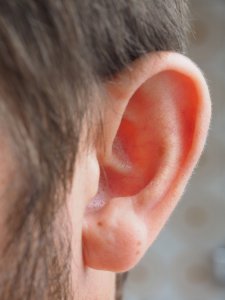Treating Central Auditory Processing Disorders (CAPDs) among Children and Adults
Auditory processing may be conceptualized as a continuum of skills, beginning with signal reception at the ear and ending when one executes a response. These various skills interact in a dynamic manner to allow the listener to use effectively what is heard. These skills include, but are not limited to, hearing sensitivity and signal transmission, attention to verbal information, central auditory processing, phonologic processing, linguistic processing, and verbal organization and output.1 Hearing sensitivity and signal transmission are subserved by centers in the peripheral auditory system, while central auditory processing is subserved by centers in the central auditory nervous system (CANS) and represent the neural processing of the incoming acoustic signal. Phonologic and linguistic processing involve attaching meaning to the incoming signal, subserved by Wernicke’s area in the temporal lobe, while output and organization require the additional action of the frontal lobes and motor/premotor cortices.
DIFFERENTIAL DIAGNOSIS
Differential diagnosis, using formal and informal assessment tools, “teases out” auditory deficits, if any, from among other deficits having shared symptomatology and allows the examiner to clarify the nature of observed behavioral deficiencies and to describe the impact of the specific deficit on the listener’s life. In general, the central auditory processing skills include:
- Auditory discrimination, the ability to analyze fine acoustic changes in speech and non speech spectra
- Temporal processing, the CANS’ ability to use timing aspects of the signal including duration and sequencing/ordering cues, and
- Binaural processing, including brainstem level interaction, important for sound localization and cortically-based integration and separation skills, necessary for processing multiple and/or competing signals.
Because no one test can assess only one central auditory skill, one must examine patterns of performance across tests assessing these skills in order to discern the unique profile of central auditory, or other deficiency in order to develop deficit-specific treatment plans.
 Impaired central auditory discrimination means the listener’s auditory system is working harder than that of a typical listener to extract the fine acoustic changes within signal spectra, even under optimal conditions. The listener risks difficulties when noise is present, in highly reverberant environments (e.g., arenas, restaurants), when extra visual and/or contextual cues are not available, or when listening to a soft-spoken speaker or one with a pronounced accent. As the acoustic or linguistic conditions deteriorate, more neural energy is expended to process the acoustic portions of the signal, leaving less energy for higher-order linguistic-cognitive processing. Processing inefficiency can result in fatigue and reduced listening comprehension. These behavioral listening difficulties may lead to secondary psychosocial issues including social withdrawal or depressive disorder and can create difficulties in communication (e.g., vocabulary, syntax, semantics, and second language acquisition) and/or academic skills (e.g., reading decoding, spelling, notetaking, and/or direction following).2 Listeners with impaired discrimination struggle on central auditory tests of degraded speech (e.g., recognition of filtered or time-compressed targets) and/or measures of temporal discrimination (e.g., temporal gap detection). Binaural and/or right ear deficits may be observed on dichotic listening tests, especially those with relatively substantial linguistic demand (e.g., dichotic words versus dichotic digits).
Impaired central auditory discrimination means the listener’s auditory system is working harder than that of a typical listener to extract the fine acoustic changes within signal spectra, even under optimal conditions. The listener risks difficulties when noise is present, in highly reverberant environments (e.g., arenas, restaurants), when extra visual and/or contextual cues are not available, or when listening to a soft-spoken speaker or one with a pronounced accent. As the acoustic or linguistic conditions deteriorate, more neural energy is expended to process the acoustic portions of the signal, leaving less energy for higher-order linguistic-cognitive processing. Processing inefficiency can result in fatigue and reduced listening comprehension. These behavioral listening difficulties may lead to secondary psychosocial issues including social withdrawal or depressive disorder and can create difficulties in communication (e.g., vocabulary, syntax, semantics, and second language acquisition) and/or academic skills (e.g., reading decoding, spelling, notetaking, and/or direction following).2 Listeners with impaired discrimination struggle on central auditory tests of degraded speech (e.g., recognition of filtered or time-compressed targets) and/or measures of temporal discrimination (e.g., temporal gap detection). Binaural and/or right ear deficits may be observed on dichotic listening tests, especially those with relatively substantial linguistic demand (e.g., dichotic words versus dichotic digits).
 Listeners with impaired temporal processing skills may exhibit difficulty on tests of temporal discrimination and resolution or may be deficient in their ability to imitate temporal patterns, resulting in impaired interpretation of prosodic cues. Inability to access these specific timing cues may manifest as inconsistent processing of rapid speech and/or difficulties listening in highly noisy or reverberant environments, when listening to unfamiliar vocabulary, an unfamiliar speaker, or to someone not speaking clearly. The listener may misperceive the intent of the message or perceive one that is very different from that which was spoken, resulting in miscommunication.3 Functional challenges may be seen in reading, spelling, direction following, note-taking, attention, working memory, problem-solving, recognition and use other types of sensory patterns (e.g., visual, tactile), or in pragmatic, and social language, including difficulty understanding sarcasm and recognizing and using nonverbal pragmatic language cues such as facial expressions, body language and gestures.2,4,5
Listeners with impaired temporal processing skills may exhibit difficulty on tests of temporal discrimination and resolution or may be deficient in their ability to imitate temporal patterns, resulting in impaired interpretation of prosodic cues. Inability to access these specific timing cues may manifest as inconsistent processing of rapid speech and/or difficulties listening in highly noisy or reverberant environments, when listening to unfamiliar vocabulary, an unfamiliar speaker, or to someone not speaking clearly. The listener may misperceive the intent of the message or perceive one that is very different from that which was spoken, resulting in miscommunication.3 Functional challenges may be seen in reading, spelling, direction following, note-taking, attention, working memory, problem-solving, recognition and use other types of sensory patterns (e.g., visual, tactile), or in pragmatic, and social language, including difficulty understanding sarcasm and recognizing and using nonverbal pragmatic language cues such as facial expressions, body language and gestures.2,4,5
Binaural processing including binaural integration and separation, is a fundamental central auditory skill set and poor scores on dichotic listening tests may be seen in cases of impaired auditory discrimination, impaired right hemisphere temporal patterning ability, impaired interhemispheric cooperation, or inefficient intra-hemispheric communication. If the listener’s underlying deficit is impaired interhemispheric communication, the examiner will observe excessive left ear suppression on dichotic listening tests as well as deficiency in describing, although not imitating, tonal patterns. Referred to by many as an integration deficit, this impairment adversely affects the ability to process multiple incoming targets quickly and efficiently. Deficit in skills needed for information integration may affect listening comprehension, academics, phonologic, cognitive-communicative, and intersensory processing.2,6,7 As listening demands increase, the listener may become less tolerant of extraneous distraction. Fatigue may set in and listening attitude may deteriorate with the listener appearing inattentive or confused.5,7 A listener who performs adequately on tests taxing auditory discrimination and temporal processing but poorly on dichotic listening tests may do so because of inefficient intra-hemispheric communication. This deficit, characterized by significant auditory-language processing difficulties is believed to be related to dysfunction in the communication between the primary (Heschl’s gyrus) and secondary or auditory association (Wernicke’s area) cortices of the dominant (usually left) hemisphere.2,6 This intra-hemispheric deficit impacts language processing and the listener has difficulty attaching linguistic meaning to incoming acoustic signals quickly and efficiently, i.e., associating the auditory with language. Secondary effects of impaired intra-hemispheric communication include challenges in memory, comprehension – reading or listening, specific language usage, and social/pragmatic communication.2–4,7
Finally, an examiner may note a unique combination of central auditory test difficulties characterized by poor scores on tests requiring the reporting of multiple or precisely sequenced targets with errors of omission and ordering, adequate performance on single target and/or free recall tasks, difficulty recognizing speech in any background noise, atypical crossed reflexes and/or otoacoustic emissions.3 These listeners are likely experiencing the effects of impaired function of the frontal and prefrontal cortices or efferent (i.e., motor) pathways.1,2,4,6 The listener experiences challenges when asked to organize and execute a response to verbal information with issues noted in planning, applied problem-solving, listening comprehension, direction following, spelling, verbal or written expression, word finding, regulation, and executive functioning.
DIFFERENTIAL INTERVENTION
In differential intervention, deficit-specific treatment procedures designed to rehabilitate the system (i.e., remediation) are implemented along with deficit-specific management strategies designed to minimize the deficit’s adverse effects. Remediation of central auditory processing disorders (CAPDs) is based upon neural plasticity, the brain’s ability to adapt and change in response to internal and/or external changes.
BOTTOM-UP THERAPY
 Bottom-up therapy is training that is stimulus driven, adaptive, repetitive and predicated on the assumption that the listener knows “what to do” and “how to do it,” but needs practice to change a skill set. Virtually any auditory skill that can be assessed can be trained, including auditory discrimination, binaural processing, and temporal processing. Much of this training can now be accomplished with computer assisted programs. By using synthesized or digitized speech, varying consonant and vowel feature contrasts, altering signal duration or frequency characteristics, or adding noise, programs such as Fast Forword,8 Aerobics,9,10 HearBuilder,11 and LACE12 systematically adapt the auditory signal through increasingly difficult levels of “play” in an effort to (re)engage a presumably inefficient auditory discrimination mechanism. Programs from Acoustic Pioneer13 and those in development by Chermak, Weihing, & Musiek14 use adaptive, repetitive activities to enhance binaural processing including brainstem-based binaural interaction and cortical level dichotic listening and temporal processing skills, including interhemispheric communication, left hemisphere-based temporal resolution, and right-hemisphere-based temporal patterning.
Bottom-up therapy is training that is stimulus driven, adaptive, repetitive and predicated on the assumption that the listener knows “what to do” and “how to do it,” but needs practice to change a skill set. Virtually any auditory skill that can be assessed can be trained, including auditory discrimination, binaural processing, and temporal processing. Much of this training can now be accomplished with computer assisted programs. By using synthesized or digitized speech, varying consonant and vowel feature contrasts, altering signal duration or frequency characteristics, or adding noise, programs such as Fast Forword,8 Aerobics,9,10 HearBuilder,11 and LACE12 systematically adapt the auditory signal through increasingly difficult levels of “play” in an effort to (re)engage a presumably inefficient auditory discrimination mechanism. Programs from Acoustic Pioneer13 and those in development by Chermak, Weihing, & Musiek14 use adaptive, repetitive activities to enhance binaural processing including brainstem-based binaural interaction and cortical level dichotic listening and temporal processing skills, including interhemispheric communication, left hemisphere-based temporal resolution, and right-hemisphere-based temporal patterning.
TOP-DOWN THERAPY
In top-down therapy, the listener learns to “work around” the auditory impairment by accessing other signal cues, e.g., contextual, linguistic, or visual as well as their own linguistic-cognitive skills, such as listening for meaning or self-advocating. By teaching strategies for comprehension, working memory, information recall and retrieval, and/or situational problem-solving, the adverse effects on the communication process are alleviated. While bottom-up therapy may be conceptualized as applying a “train-train-train” technique, top-down therapy employs a more traditional “teach-teach-teach” approach and is likely best accomplished through individualized one-one or small group sessions that allow for client interaction, role-playing, and counseling. Descriptions of therapist-directed top-down remediation programs may be found in Chermak,15,16 Gartescki,17 and Kelly.18 Although their effectiveness remains open for debate, there are computer programs that purport to improve higher-order information processing through adaptive training techniques, including Interactive Metronome,19 Seeing & Hearing Speech,11 and CogMed.20
TREATMENT EFFECTIVENESS (Or How Do I Know Which Therapy Type to Choose)
To document treatment effectiveness, there must be evidence that change has occurred because of the treatment and not maturation or some uncontrolled factor.21 A growing body of research supports the use of top-down and/or bottom-up treatment to reduce or resolve auditory processing impairments and to support development of compensatory strategies. Auditory skills training can reduce and/or resolve specific central auditory impairment.22–27 Therapy that targets higher order cognitive-communicative skills minimizes the adverse effect of the auditory deficit on a listener’s life.3,24,25,28,29 The onus for determining which type of therapy is appropriate for which listener falls on the examiner. Armed with a deficit-specific diagnosis and knowledge of the listener’s specific functional needs, the examiner is able to winnow down the menu of treatment choices to those best able to meet a client’s needs. The therapist must examine a program’s treatment outcome data, if available, the underlying science upon which any treatment program or type is based, and the “fit” of the program to the client’s deficit and needs (i.e., does the program seek to improve the identified deficit?). An intervention process that is tailored to the client’s unique neurocognitive and functional needs, grounded in “good science”, provided in a timely manner, and extended beyond the therapeutic environment can reduce/resolve auditory and related impairments and mitigate the deficit’s impact on listener’s daily life.
REFERENCES
- Richard GJ. The source for processing disorders. Rock Island, IL: LinguiSystems, Inc; 2001.
- Bellis T and Ferre J. Multidimensional approach to differential diagnosis of central auditory processing disorders in children. J Am Acad Audiol 1999;10:319–28.
- Bellis T. Assessment and management of central auditory processing disorders in the educational setting (2nd ed.). San Diego, CA: Plural Publishing; 2003.
- Bellis T. Interpretation of APD test results. In T.K. Parthasarathy (Ed.) An introductionto auditory processing disorders in children (pp.145-160). Mahwah, NJ: LawrenceErlbaum Associates; 2006.
- Ferre J. Differential intervention for (C)APD, attention deficit hyperactivity disorder, and learning disability. In Chermak G. & Musiek, F. (Eds.) Handbook of (central) auditory processing disorder: volume II: comprehensive intervention. San Diego, Plural Publishing; 2007;
- Ferre J. Behavioral therapeutic approaches for central auditory problems. In Katz, J. (Ed.). Handbook of clinical audiology (5th edition) Philadelphia: LippincottWilliams and Wilkins; 2002.
- Ferre J. Management strategies for APD. In T.K. Parthasarathy (Ed.). An introduction to auditory processing disorders in children. Mahwah, NJ: Lawrence Erlbaum Associates; 2006.
- Scientific Learning Corporation. Fast ForWord training program for children. Procedure manual for professionals. Berkeley, CA. Author; 1997.
- Cognitive Concepts, Inc. Earobics, auditory development and phonics program [Computer software]. Evanston, IL. Author 1997.
- Cognitive Concepts, Inc. Earobics, step two auditory development and phonics program [Computer software]. Evanston, IL. Author;1998.
- Sensimetrics, Inc. SHS user guide; 2013. Retrieved from http://www.sensimetrics.com.
- Sweetow R and Henderson Sabes J. The case for LACE: Listening and auditory communication enhancement. Hear J 2004;37:3:32–38.
- Barker M. Zoo Caper Skyscraper and Insane Earplane. [Computer software]; 2015. Retrieved from http://acousticpioneer.com.
- Chermak G, Weihing J, and Musiek, F. Sound Auditory Training. [Computer software]; 2016. Retrieved from http://www.pluralpublishing.com/sat.
- Chermak, GD. Metacognitive approaches to managing central auditory processing disorders. In: Masters MG, Stecker NA, and Katz J, (Eds), Central auditory processing disorders: Mostly management (49–61). Boston, MA: Allyn & Bacon; 1998.
- Chermak, G. Central resource training: cognitive, metacognitive and metalinguistic skills and strategies. In: Chermak G and Musiek F (Eds). Handbook of (central) auditory processing disorder: Comprehensive Intervention Volume II (107-166). San Diego, CA: Plural Publishing, Inc; 2007.
- Garstecki D. Auditory-visual training paradigm for hearing impaired adults. J Rehab Audiol 1981;14:223–8.
- Kelly D. Central auditory processing disorders: Strategies for use with children and adolescents. San Antonio: The Psychological Corporation; 1995.
- InteractiveMetronome, Inc. IM specific research and white papers. 2015. Retrieved from http://www.interactivemetronome.com.
- Soderqvist S and Nutley S. Cogmed working memory training. [Computer software]. 2016. Retrieved from http://cogmed.com/research.
- Goldstein H. Assessing clinical significance. In Olswang, L. Thompson C, Warren S, and Minghetti, N. (Eds.) Treatment efficacy research in communication disorders. Rockville, MD: American Speech-Language-hearing Association. Author; 1990.
- American Speech-Language-Hearing Association. Technical report: (Central) auditory processing disorders. Rockville, MD: Author; 2005
- Bellon-Harn M. Targetting prosody: A case study of an adolescent. Communicat Disord Quarterly 2011;32:109–17.
- Bellon-Harn M, Harn W, and Watson G. Targeting prosody in an eight-year-old child with high-functioning autism during an interactive approach to therapy. Child Lang Teach Ther 2007;23:153–74.
- Chermak GD. Metacognitive approaches to managing central auditory processing disorders. In Masters MG, Stecker NA, Katz J, (Eds.), Central auditory processing disorders: Mostly management. Boston, MA: Allyn & Bacon; 1998.
- Chermak GD and Musiek FE. Auditory training principles and approaches for remediating and managing auditory processing disorders. Semin Hear 2002;23:297–308.
- Ferre J. Aural Rehabilitation & Central auditory processing disorders (CAPD): Outcome evidence among school-age children. Educat Audiol Rev 2010;27:8–17.
- Chermak G. Central resource training: cognitive, metacognitive and metalinguistic skillsand strategies. In G. Chermak & F. Musiek (Eds.). Handbook of (Central) AuditoryProcessing Disorder: Comprehensive Intervention Volume II. San Diego,CA: Plural Publishing, Inc; 2007.
- Ferre JM. The M3 model for treating central auditory processing disorders. In Masters MG, Stecker NA, Katz J (Eds.) Central auditory processing: Mostly management. Boston, MA: Allyn & Bacon; 1998.

